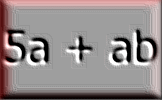Level
Drag the green dice faces onto the yellow net so that when it is folded to form a cube the numbers on opposite faces
Other Levels:
Congratulations!
Claim a trophy by clicking on the button below or try another level.

Your answer is not correct.
You can press the 'Clear' button and start again but check carefully the wording of the challenge below.





Valerie Bibbons, Cornwall
Friday, March 30, 2007
"Drag the numbers onto the net so that when it is made into a cube the sum of the opposite numbers are consecutive."
Nick Moore, Sir William Robertson High School
Monday, May 14, 2007
"Drag the numbers onto the net so that when it is folded to form a cube
numbers on opposite faces add up to factors of 36."
Kaleb, North Dakota
Thursday, December 4, 2008
"Multiply the numbers so the opposite sides equal 6,10, and 24."
Josh White, Marshfields School
Monday, May 11, 2009
"Can you make each opposite number of a dice times together to create a multiple of 6?"
Reggie, Cork
Saturday, June 6, 2009
"If you add the number on the opposite faces it will be 12 or less."
Mark Lawrence, Birmingham
Thursday, October 29, 2009
"Opposite faces sums are consecutive and less than 9."
Jane Woodhams, Croydon
Sunday, June 5, 2011
"When folded into a cube one pair of opposite faces equal a prime number the other four faces do not have either an odd next to an odd or an even next to an even
example 6 opposite 5
1 opposite 3
2 opposite 4."
4R Maths Magicians, Portswood Primary School
Monday, November 7, 2011
"Drag the numbers into the boxes so the oppesite numbers so when you divide the smaller number by the bigger number the result is less than 10."
James Jig, Fred Nicholson School
Monday, March 5, 2012
"Numbers on opposite sides add up to multiples of three."
Arya, Singapore
Friday, March 30, 2012
"Drag the numbers so that when the cube is folded up, the numbers on the opposite sides add up to prime numbers."
Joe Woods, Wigan
Sunday, November 25, 2012
"Arrange the numbers so that when it is folded to make a cube, opposite faces multily to give an even number."